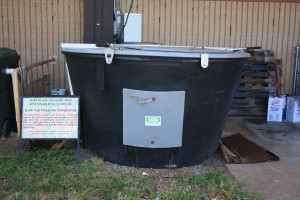Sustainability is a cycle, and Ronald Takahashi, department chair of culinary arts at Kapiʻolani Community College wants to take the first steps to create a model of sustainability for all who wish to follow.
KapCC currently features many systems that elevate the culinary program above the rest by using ingredients harvested from gardens that use fertilizer composted on campus, because food is only as good as the soil it grew in.
Which is why, when KapCC hoped to create a better process for preparing our food, our leaders started right under our feet.
“Our job is to create models of sustainable food service that restaurants or hotels can emulate,” Takahashi said, about why he works to propel the sustainability effort on campus.

An earth tub is a forced air composting system that is churned by an auger twice daily to create zero pathogen laced fertilizer.
The cycle starts in the soil, and on campus several compost systems are already in place. Next to the cafeteria is a vermicompost system, which utilizes worms to break down the proteins in waste food and vegetables and excrete superior fertilizer.
This type of compost is not ideal for root vegetables, so KapCC also utilizes an earth tub, a forced air composter.
The earth tub is an enclosed system that creates completely sterile compost. KapCC recently installed a bio processor that can turn waste oil into bio diesel as well as two types of aquaponics systems adjacent to our campus herb gardens. The bubble system uses air to lift nourished water back into the system and is more complicated to set up; however, it is more energy cost effective over the second pump system.
“It’s the means of trying to provide as many models for the industry to follow,” Takahashi said.
Takahashi said all these sustainability practices will culminate in the production of the new culinary building and restaurant, that will be built as a golden facility for restaurants and hotels to imitate “in everything from energy efficiency, construction, building design, and water efficiency.”
Currently, only culinary students have taken part in the sustainability practices on campus. Starting this fall, the culinary department will begin an awareness campaign to get all students involved in the cycle to sustainability.
The culinary department will ask students to separate their waste food after they eat at the cafeteria, 220 Grille or Kaʻikena Restaurant into designated bins so that it can be properly composted.
The composting system is the first step to a cleaner food service industry as it reduces the amount of waste that needs to be picked up by trash collectors, reduces the money spent on fertilizer for herbs and plants grown on campus and the remainder of food waste is donated to Animal Haven, a special group that helps abandoned farm animals.
While developments continue at the new culinary department and restaurant alongside Diamond Head, sustainability efforts on KapCC’s campus continue to multiply.
Takahashi said production efforts that could create opportunities for students and new local businesses. KapCC plans to coordinate with Leʻahi Hospital to provide 12,000 square feet of kitchen space along with privately funded grants to create a food processing center. Currently, 90 percent of our food we eat in the islands is shipped from the mainland including food served to public schools.
The goal of the food-processing center is to partner with local farmers to create new business and provide fresh, never frozen meals that can be distributed to the Department of Education system.
“We are training people for business, we have to make everything cost effective,” Takahashi said. “We have to show it makes business sense, then it becomes do able.” Takahashi said, on the business of sustainability.
While sustainability efforts continue on campus you can do your part by supporting local farms on the island as well as recycling or even starting your own compost system at home. Students are encouraged to inform others about the new compost campaign beginning this fall. We can all see a cleaner, more green future.
The journey begins with a first step.
